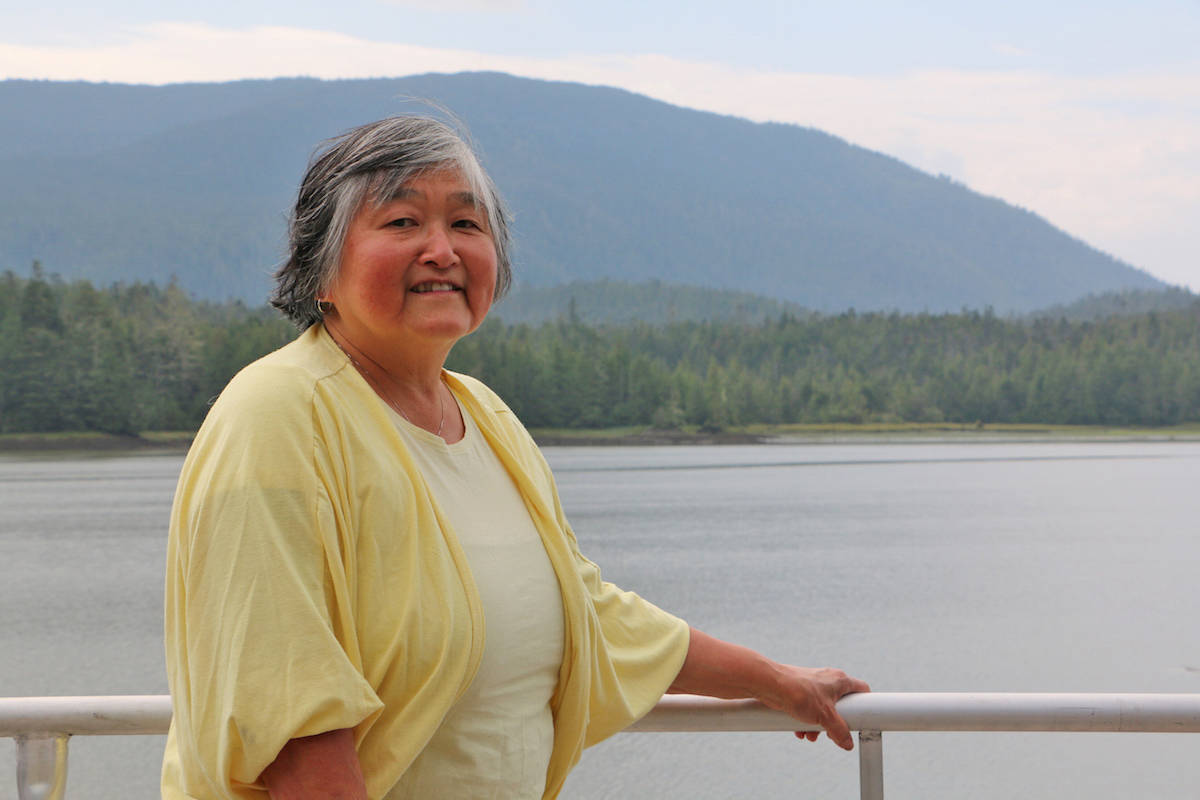Love and Mona Izumi. Those were the silver linings for a young couple stuck in a Japanese internment camp during the war.
The woman, who was from a farm in New Westminster, and the fisherman, from the north coast, would have never met if it were not for those camps.
Fast forward several years later, the couple is freed from the camp and faced two options: repatriate back to Japan or move east. They were no longer welcome on the west coast.
The first alternative was not an option, they were born in Canada. They opted to head to Montreal with both of their families and, in 1950, that is where their baby girl Mona was born.
“I always say there’s this silver lining to every cloud because I wouldn’t be here had it not been for the internment,” Izumi said.
READ MORE: History behind the cherry trees the feds cut down in Prince Rupert
Izumi tells this story at least once a week to the visitors at the North Pacific Cannery. She volunteers so she can share her family’s history.
| Tourists visit The North Pacific Cannery and are encountered with a pleasant surprise as volunteer Mona Izumi comes to greet them and tell them the story about her family's history to the site (Jenna Cocullo / The Northern View) |
April 1, 1949 was the day where Japanese Canadians were allowed to move freely in Canada. Mona’s dad, a fisherman at heart and his own boss, moved back to Port Edward for the fishing season the year she was born. When Mona turned one, she and her mom joined him at the Sunnyside Cannery, the old neighboring cannery of North Pacific.
All the cannery villagers were segregated communities. The Izumis lived in the Japanese section right next door to Mona’s grandparents. Izumi describes her time there as “living in a village of grandparents.” The Japanese community only had a handful of families with the majority being older folk without children.
Unlike North Pacific, Sunnyside did not close down at the end of the salmon season, so they lived on the ground year round.
The First Nations communities, mostly the Tsimshian from Hartley Bay, were Izumi’s neighbouring communities. Some had kids but only a few stuck around the full year. Izumi’s friends were mostly the Tsimshian kids. Being a young child, she was not allowed to wander any further in the village.
Further down the boardwalk were the Nisga’a who tended to go back to the Nass Valley when the fishing season came to a close. The Europeans were all management so of course no one saw much of them because “they literally lived on the
other side of the tracks,” said Izumi. Every cannery had at least one bunkhouse full of Chinese men. No women or children. Until she moved to Prince Rupert, Izumi had never seen a Chinese woman in her life.
Her community didn’t have electricity, only a generator which was shut down by 7 p.m. every night, to be replaced by a kerosene lantern for light. Her home had a stove in the kitchen for cooking and a little oil stove in the living room and that was the extent of the heat. Sometimes it got very cold, being so close to the water. Izumi never minded it much.
“Well, you know, as a kid, it’s your life and you don’t really think much of it. It’s your life and you kind of accept it for what it is, you don’t know any better,” she said.
A highway connecting the village to Port Edward was also one of the many amenities lacking at the time. The only ways in and out of the village were by boat or train. When it was time for Izumi to start school in 1956, she moved to Port Edward to live with her aunt.
On Friday nights she would take the train home for the weekends only to start all over again by Sunday. Her routine lasted for a year until her family moved to Prince Rupert.
READ MORE: Heritage BC looks for Japanese sites
Aside from a year spent in Terrace, and going away for college, Izumi has lived in Prince Rupert ever since.
Fifty-one years ago, at the age of 18, Izumi met her future husband, Taro, while working at a cannery owned by a Japanese company that processed salmon roe. They would go on to have two children together who are now 45 and 48.
Izumi earned a degree in math and taught the subject at Coast Mountain College (then known as North Coast Community College) for 32 years. Now in retirement, Izumi volunteers at North Pacific Cannery.
“When I came out three years ago and said, you know, I’d like to volunteer, I guess I started because I grew up in this area and it sort of feels like home.”
Izumi began volunteering in data entry and digitizing thousands of artifacts catalogued on index cards. When they opened up the Japanese houses last year, Izumi went from preserving the history at the cannery to telling her own.
| Mona Izumi volunteered at The North Pacific Cannery for three years archiving. (Jenna Cocullo / The Northern View) |
“It’s wonderful that they’ve been able to preserve what they have here. And it is important that people know what the life was like. Really when you think of it 70 years isn’t a great deal of time when you’re looking at history. But Canada has a very short history. So I think it’s important that history is preserved and people hear different sides of its story,” she concluded.
READ MORE: Heart of Our City: Nobody is perfect, including parents
Jenna Cocullo | Journalist
Jenna Cocullo
Send Jenna email
Like the The Northern View on Facebook
Follow us on Twitter
